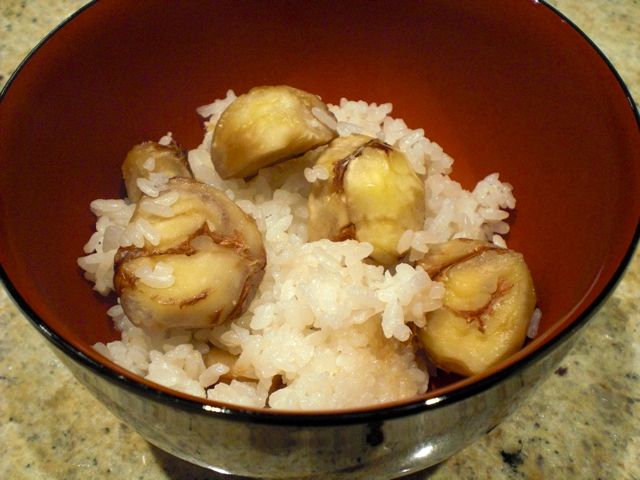Chestnuts are such a typical seasonal food item in Japan for deepening autumn. As a kid in Japan, we ate them every fall, usually boiled and it was something I generally liked. We had quite a few mature chestnut trees in our neighborhood. Many half open "Iga" いが or outer prickly shells were on the ground and getting chestnuts from those shells was always tricky for young kids. The trick was getting the nut without being pricked. In North America, because of
Chestnut blight, most of the North American Chestnuts trees were wiped out by 1940. Chestnuts, maybe as a result, appear not to be a very popular food item. The vast majority of chestnuts we see here are imported from Europe (see P.S. below). My wife tells me that her childhood memory of chestnuts was the yearly ordeal (usually around Christmas) of roasting them in the shell over an open fire in the fireplace. While they smelled great, they weren't worth the bother. Once she busted into them, they were a major disappointment--dry, chalky, tasteless.

On one of our first trips to Japan as a married couple, we came across a roasted sweet chestnut vendor, "tenshin amaguri" 天津甘栗, under the raised railroad tracks in Shinbashi 新橋 area of Tokyo. The smell wafting from the cart was divine. I suggested we get some and my wife said, "Don't bother" and kept walking. I got them anyway and the smell enticed her to try some. She was astounded at how good they were. She insisted they couldn't be the same thing she ate as a child. Last week I found chestnuts in the shell at our gourmet grocery store. I, again, could not resist and got some chestnuts for a Japanese chestnut rice or "kurigohan" 栗ごはん. Again my wife advised, "Don't bother" and warned me that they would not taste like the ones I was used to.
I first soaked the chestnuts (15 or so, upper left in the image below) in water for several hours to make it easier to peel the outer hard skin. You could also parboil to make it easier to remove the skin. It is easy to take off the hard skin called "onikawa" 鬼皮 by cutting off the bottom and peeling off the hard skin but the chestnuts are still covered with the bitter-tasting inner skin (upper right). The most labor intensive part is removing the inner skin called "shibukawa" 渋皮 meaning "bitter skin". I just used a small paring knife to remove the inner skin but it is not easy. I put these cleaned chestnuts into water to prevent discoloration (lower left).
I again used the earthenware rice cooker called "
Kamado san" like I did when I made "
Matsutake gohan", I used kelp soaked water and added sake (2 tbs) and salt (1 tsp) to make 400ml of the cooking liquid. I did not use soy sauce to prevent the rice from darkening. I washed and drained the rice (2 Japanese cups or 360ml). I added the rice and the liquid into the cooker, and placed cleaned chestnuts on the top (lower right in the above image). As per the instruction that came with the cooker, I put on the inner lid and then the outer lid. I cooked it on a medium high flame for 14 minutes and then let it stand for 20 minutes.
Here is the end product (above). I was a bit disappointed--I "shouldn't have bothered". The chestnuts were dry, chalky and pretty tasteless (as my wife predicted), although they were certainly edible. The rice itself was quite nice. We may try this again with bottled boiled chestnuts from France next time. But at least, I feel like I paid some respect to autumn, which has firmly arrived here.

No comments:
Post a Comment